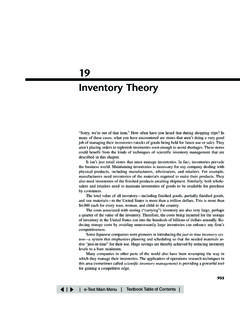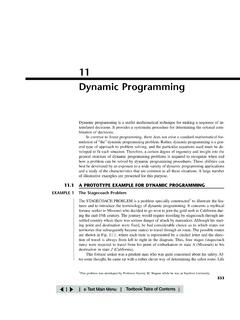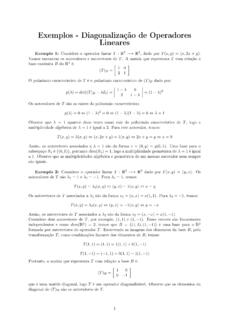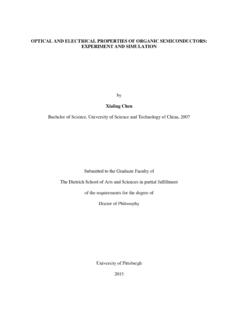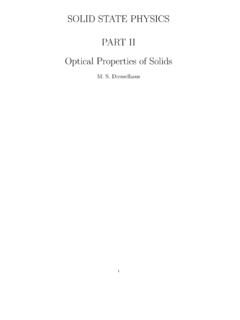Transcription of OPTICAL PROPERTIES OF DIELECTRIC AND …
1 Chapter 12. OPTICAL PROPERTIES OF DIELECTRIC AND SEMICONDUCTOR. thin FILMS. I. Chambouleyron Instituto de F sica Gleb Wataghin, Universidade Estadual de Campinas UNICAMP, 13083-970 Campinas, SP, Brazil J. M. Mart nez Instituto de Matem tica, Universidade Estadual de Campinas UNICAMP, 13083-970 Campinas, SP, Brazil Contents 1. Theory .. 1. Historical Note .. 1. The General Problem .. 2. Light Matter Interaction .. 4. Basic Formulae for Transmitted and Reflected Waves .. 7. Nonnormal Incidence and Linear-System Computations .. 14. The Effect of a Thick Substrate.
2 15. Computational Filter Design .. 17. Optimization Algorithm for thin Films .. 18. 2. Applications of thin Films .. 18. Antireflection Coatings .. 18. A Reverse Engineering Problem: The Retrieval of the OPTICAL Constants and the Thickness of thin Films from Transmission Data .. 22. 3. Conclusions .. 28. Acknowledgment .. 29. References .. 30. 1. THEORY that moment due to Newton's belief that light beams were the propagation of a stream of particles, Newton rejecting the idea Historical Note of light being a wavelike perturbation of the ether. In 1690, Huygens [2] published his Treatise on Light, in which he pro- Interference phenomena of light waves occur frequently in na- ture, as in the colored reflection produced by feathers and wings posed that light was a disturbance propagating through the ether of birds and many insects.
3 The interference pattern given by as sound moves through air. There is no reference to wave- oily substances onto water has been certainly noticed by man lengths, though, or a connection of these and color. In 1768, since ancient times. The origin of such effects, however, re- Euler [3] advanced the hypothesis that the colors we see de- mained unclear until relatively recent times. The first systematic pends on the wavelength of wave light, in the same way as study on interference was undertaken by Newton [1], the well- the pitch of the sound we hear depends on the wavelength of known Newton rings, obtained from multiple reflections of light sound.
4 In 1801, in the lecture On the theory of light and col- in the tiny air layer left between a flat and a little convex piece ors, delivered before the Royal Society, Young sketched the of glass. The effect, however, was not properly understood at current theory of color vision in terms of three different (pri- Handbook of thin Films Materials, edited by Nalwa Volume 3: Volume Title Copyright 2001 by Academic Press All rights of reproduction in any form reserved. 1. 2 CHAMBOULEYRON AND MART NEZ. mary) colors. Young's experiments on the interference of two light beams [4] were made around 1800 and published in 1807.
5 They gave the ultimate proof of the wave nature of light and allowed the determination of the wavelength of visible light. In the words of Herschel [5], .. Dr. Young has established a prin- ciple in optics, which, regarded as a physical law, has hardly its equal for beauty, simplicity, and extent of applications, in the whole circle of science.. The experimental means by which Dr. Young confirmed this principle, which is known in optics by the name of interference of the rays of light, were as simple and satisfactory as the principle itself is beautiful.. Newton's col- ors of thin films were the first phenomena to which the author applied it with full success.
6 Based on the experiments of Malus on the polarization of light by ordinary reflection at the surface of a transparent body, Young proposed a few years later that light waves were transverse perturbations of the ether and not Fig. 1. The figure sketches the general OPTICAL coating problem. A light beam longitudinal, as sound waves. The consequences of the finding impinges onto a stack of DIELECTRIC thin layers supported by thick substrate. The kept physicists busy for the next hundred years. It was Fresnel radiation is partly transmitted and partly reflected, both depending on photon energy and layer thickness.
7 Part of the radiation may be internally absorbed. that put Young's results on a firm mathematical basis. He estab- lished the relations between the amplitudes of the reflected and refracted waves and the incident waves, known as the Fresnel beam. Sometimes, a change of phase also occurs. As the dis- formulae. tances between layer boundaries are comparable to the photon OPTICAL coatings remained a subject of laboratory curiosity wavelength, multiplyreflected or transmitted beams are coher- in the sense that no industrial applications occurred until the ent with one another.
8 Consequently, the total amount of light twentieth century, with the notable exception of mirror produc- reflected and transmitted by the structure results from the al- tion. Until the late Middle Ages, mirrors were simply polished gebraic sum of the amplitudes of these partially reflected and metals. At a certain unknown moment, the Venetian glass work- partially transmitted beams. This property is at the base of a ers introduced glass silvering using an amalgam of tin and large number of applications. Depending on the specific case, mercury [6]. The method lasted until the nineteenth century, the substrate (S) supporting the structure may be transparent or when the backing of glass was made with silver.
9 The develop- absorbing. Self-supported structures may be built also but, in ment of vacuum apparatus techniques allowed the evaporation what follows, the existence of a thick supporting substrate will of a large class of materials, with the ensuing application to be assumed. Hence, in the present context, a thin film is equiv- OPTICAL systems, among others. The methods to deposit thin alent to an OPTICAL coating. films in a controllable way increased at a rapid pace, as did The structure depicted in Figure 1 suggests three different the applications to different fields of industry.
10 Today, advanced problems: electronic and OPTICAL devices are manufactured involving sin- gle or multilayered structures of materials of very different (a) OPTICAL response. Calculation of the spectral response nature: electro-optic and OPTICAL materials, semiconductors , in- of a p-layered structure deposited onto a substrate of sulators, superconductors, and all kinds of oxide and nitride known PROPERTIES . The OPTICAL constants of the coating alloys. This rapid development demands accurate deposition materials as a function of photon wavelength are methods, sometimes with in situ characterization, as well as given, as well as the thickness of each layer.
